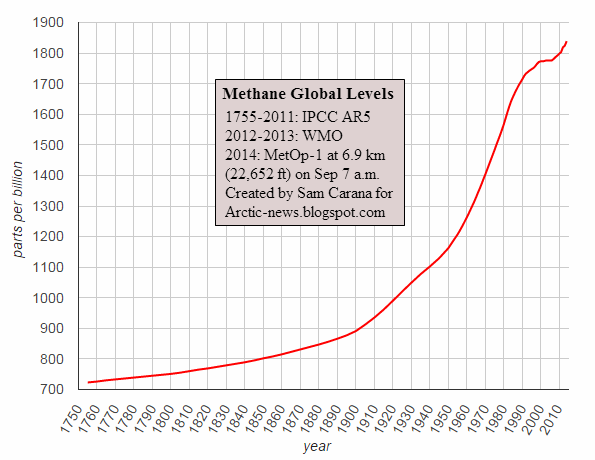On May 12, 2015, a temperature of 80.1°F (or 26.7°C) was recorded in the north of Canada, at a location just north of latitude 63°N.
High temperatures in such locations are very worrying, for a number of reasons, including:
- They are examples of heatwaves that can increasingly extend far to the north, all the way into the Arctic Ocean, speeding up warming of the Arctic Ocean seabed and threatening to unleash huge methane eruptions.
- They set the scene for wildfires that emit not only greenhouse gases such as carbon dioxide and methane, but also pollutants such as carbon monoxide (that depletes hydroxyl that could otherwise break down methane) and black carbon (that when settling on ice causes it to absorb more sunlight).
- They cause warming of the water of rivers that end up in the Arctic Ocean, thus resulting in additional sea ice decline and warming of the Arctic Ocean seabed.
The image below shows increased sea surface temperature anomalies in the area of the Beaufort Sea where the Mackenzie River is flowing into the Arctic Ocean.
The image below further illustrates the situation, with sea ice thickness (in m) down to zero where the Mackenzie River flows into the Arctic Ocean.
Things look set to get worse. The forecast for May 16, 2015, shows high temperatures extending all the way to the coast where the Mackenzie River flows into the Arctic Ocean.
Updates follow below:
Alaska is hit by high temperatures as well. The image below shows temperatures as high as 25.3°C (77.54°F) at a location just north of latitude 66°N in Alaska.
Below a forecast for May 23, 2015, showing temperatures in Alaska and neighboring parts of Canada that are 36°F (20°C) higher than they used to be (1979-2000 baseline).
The image below shows that temperatures as high as 30.2°C (86.36°F) are forecast for Alaska for May 23, 2015, along the path of the Yukon River, at a latitude of ~66 degrees North (65.98°N).
Furthermore, temperatures as high as 24.2°C (75.56°F) are forecast for the coast, close to where the Mackenzie River flows into the Arctic Ocean. Off the coast, over the water of the Arctic Ocean, temperatures as high as 8°C (46.4°F) are forecast, for a location just north of latitude 70°N, while temperatures as high as 15°C (59°F) are forecast for a location over the water of the Arctic Ocean closer to land.
As the image below illustrates, the jet stream is forecast to move across Alaska on May 23, 2015, bringing warm air into the atmosphere over the Arctic Ocean. The image gives the jet stream's speed at three locations, i.e. the jet stream is forecast to reach speeds as high as 262 km/h (162.8 mph, bottom green circle) over the Pacific Ocean, 165 km/h (102.5 mph, middle green circle) south of Alaska, and 172 km/h (106.9 mph, top green circle) over the Arctic Ocean.
Looking at salinity is a way to see the impact of rivers. The animation below, created with
Naval Research Laboratory images over the period May 16 to 20, 2015 (run on May 18, 2015), shows salinity levels falling where the Mackenzie River flows into the Arctic Ocean.
Salinity works in several ways. Falling salinity will increase the temperature at which the sea ice melts. However, such an increase can only temporarily hold back melting, as illustrated by the combination image below, comparing sea ice thickness between May 7 and May 18, 2015.
Let's have a look at some of the feedbacks that haven't been discussed much in earlier posts. The potential for rivers to contribute to sea ice decline is depicted in the diagram below (feedback #24), i.e. extreme weather causing warming of rivers that flow into the Arctic Ocean. Furthermore, evaporation rates are higher over fresh water surfaces than over saline water surfaces (feedback #26) and the resulting increase in water vapor and clouds contributes to further warming (feedback #25), while rain falling on the sea ice will also cause its albedo to decline. The latter feedback also closes some loops. in that sea ice retreat results in more open water, in turn resulting in more water vapor and clouds.

Another feedback is that, as more sea ice turns into open water, less infrared radiation will be emitted and sent out into space, since open oceans are less efficient than sea ice when it comes to emitting in the far-infrared region of the spectrum (feedback #23). Furthermore, as sea ice declines, the increase in Arctic phytoplankton warms the ocean surface layer through direct biological heating (feedback #22).
For more discussion of these feedbacks, see the
feedbacks page. In conclusion, the situation is dire and calls for comprehensive and effective action, as discussed at the
Climate Plan page.
Forecast for May 16, 2015, showing high temperatures extending all the way to the coast where the Mackenzie River flows...
Posted by Sam Carana on Friday, May 15, 2015
































.jpg)

















